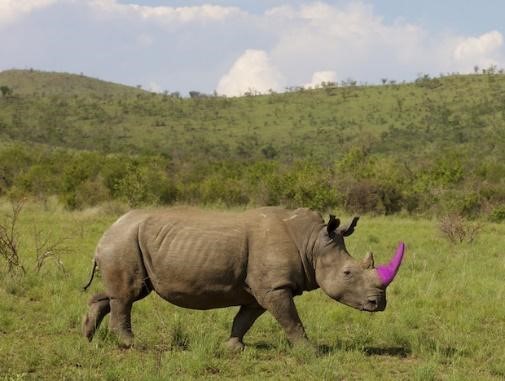An Overview of the Communities Affecting Rhino Poaching
By: Randi Olson

This is a photo taken during my first volunteer trip to South Africa. The two white rhinos are seen at Hluhluwe-iMfolozi Park, a game reserve near St. Lucia, South Africa on the west coast. The night before I flew home, these rhinos were shot and had their stumps removed, along with four other rhinos[1]. The mass killing is indicative of an employee allowing poachers in the park after hours.
Karl Marx claims that society is in a perpetual state of conflict due to competition for limited resources in his proposed conflict theory.[2] Individuals fight for domination and power over each other and those with power fight to hold on to it. Some who adhere to eastern medicine feel that they need the rhino horn to have the advantage of health, our most primitive advantage.
In a global overview of poaching, those receiving the eastern medicine are on top of the hierarchy, poachers are in the middle, and rhinos, along with their surrounding communities, are at the bottom. Karl Marx would agree that taking the power away from those at the top and giving it to those at the bottom is the only way to balance out the power. A rhino easily costs $27 million a year to protect and care for at a zoo or sanctuary.[3] Currently, crushed rhino horn goes for $65,000/kg.[4] This has effectively made the rhino more valuable dead than alive. This realization across the Black Market has put a target on the backs of all rhinos, leading to the loss of almost 10,000 rhinos to poaching, putting the population on the brink of extinction. Many Africans are too caught up in the all-encompassing fight against poverty to advocate for their wildlife populations. As the rhino population dwindles the demand for rhino horn continues to climb in countries like Vietnam who use the crushed horn as medicine to cure everything from cancer to hangovers.3 As poachers easily corrupt with large sums of money, access to the parks has become as simple as a gate being opened after hours. The loss of rhinos is a loss of African culture, heritage, and the environment which nurtured them. The South African government needs to ban the export of all ivory as illegal trade is already taking too much and South Africa simply does not have the resources to accommodate the trade.

This provocative photo of a rhino with a bright purple horn surfaced on the internet in 2013 via Heinrich van den Berg, who confirmed that the photo had been digitally altered. Though the photo itself is not astounding, the theory behind it is. Rhinos do not have blood vessels in their horns, and therefore, anything that touches the horn, inside or out, does not enter the rhino’s body. This is why dehorning is not harmful or painful and explains how scientists have managed to inject rhino horns with poison. The poison is injected through drill holes into the horn and the bright purple horn is used as a visual warning to poachers. The method relies spreading the fear of receiving poisoned medicine among eastern cultures. This raises ethical questions, as well as doubts surrounding the effectiveness of the practice, as it has yet to be seen if tainting black market ivory is a large enough deterrent to challenge long held beliefs within eastern cultures. So far, the poisoning methods have resulted in an increased value for non-poisoned horn, putting untreated rhinos at a higher risk.
Cultural change in eastern medicinal beliefs will be the longest and most difficult aspect to saving rhinos. Africans must take power in the ways they can, with dehorning and horn poisoning acting as just two approaches to this global issue. Of the highest priority is developing financial stability through jobs in South Africa so that those in charge of care or of influence in the community can have the means available to them to properly conserve their culture and condemn foreign exploitation. These efforts may be supported by signing the petition for South Africa to ban the export of ivory on Change.org [5], as well as by donating to conservation projects that prioritize the hiring of local staff, such as the innovative Akashinga[6], a community-based anti-poaching force committed to hiring local women. [7]
[1] "6 Rhino Killed in Just One Night in KwaZulu-Natal Reserve." News24. July 04,
2017. Accessed March 20, 2019. https://www.news24.com/SouthAfrica/News/6-rhino-killed-in-just-one-night-in-kwazulu-natal-reserve-20170704.
[2] Kenton, Will. "Conflict Theory." Investopedia. March 12, 2019. Accessed March
20, 2019. https://www.investopedia.com/terms/c/conflict-theory.asp.
[3] Guilford, Gwynn. "Why Does a Rhino Horn Cost $300,000? Because Vietnam Thinks
It Cures Cancer and Hangovers." The Atlantic. May 15, 2013. Accessed March 20, 2019.
https://www.theatlantic.com/business/archive/2013/05/why-does-a-rhino-horn-cost-300-000-because-vietnam-thinks-it-cures-cancer-and-hangovers/275881/.
[4] "Rhino Poaching Hits New High in South Africa, Experts Warn of Extinction in Wild."
NBCNews.com. Accessed March 20, 2019. https://www.nbcnews.com/news/world/rhino-poaching-hits-new-high-south-africa-experts-warn-extinction-flna8C11309186.
[5] “Sign the Petition.” Edited by Megan Carr, Change.org, The Global March for Elephants
and Rhinos Organisation, 2017, www.change.org/p/stop-the-ivory-trade.
[6] Mander, Damien, and Adrian Steirn. “Akashinga (‘The Brave Ones’) Female Anti-Poaching
Unit.” International Anti-Poaching Foundation, 28 Mar. 2019, www.iapf.org/akashinga/.
[7] Mitchell, Fraser, and Prisca Daka. “Four Southern African Nations Petition to
Lift the International Ivory Trade Ban.” Africa Live, Africa Live, 26 Feb. 2019, africalive.net/article/four-southern-african-nations-petition-to-lift-the-international-ivory-trade-ban/.

